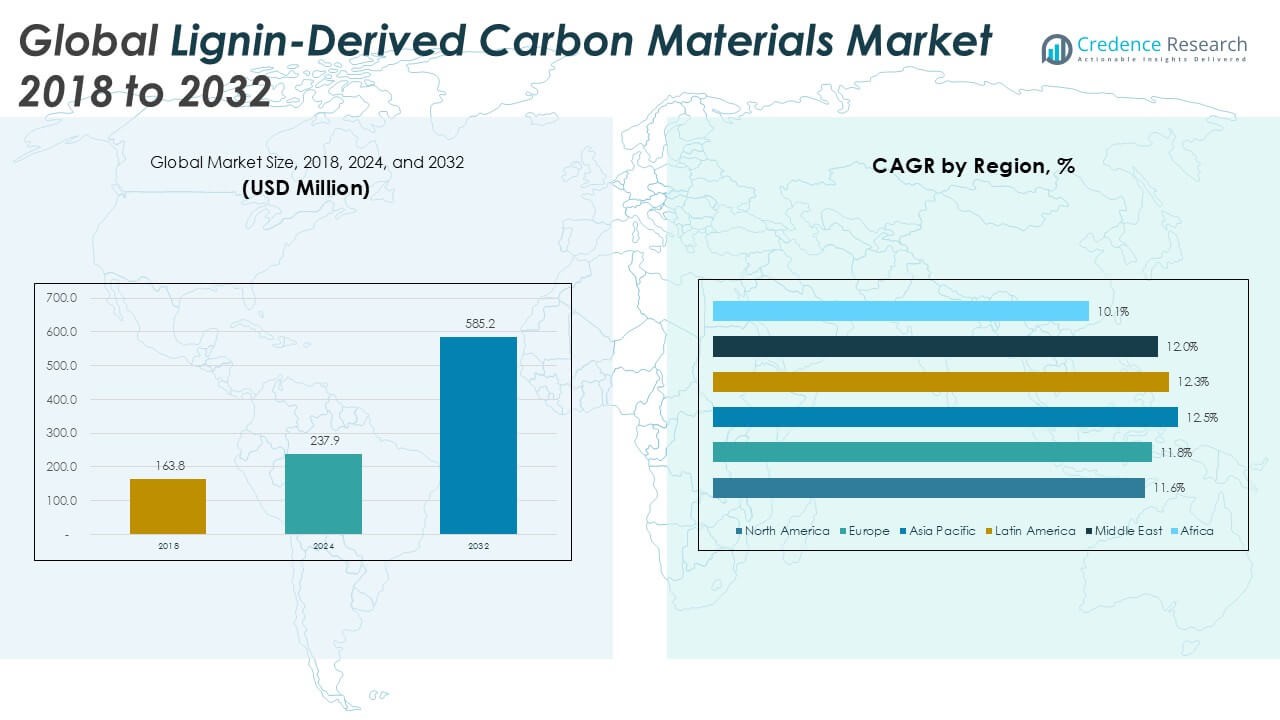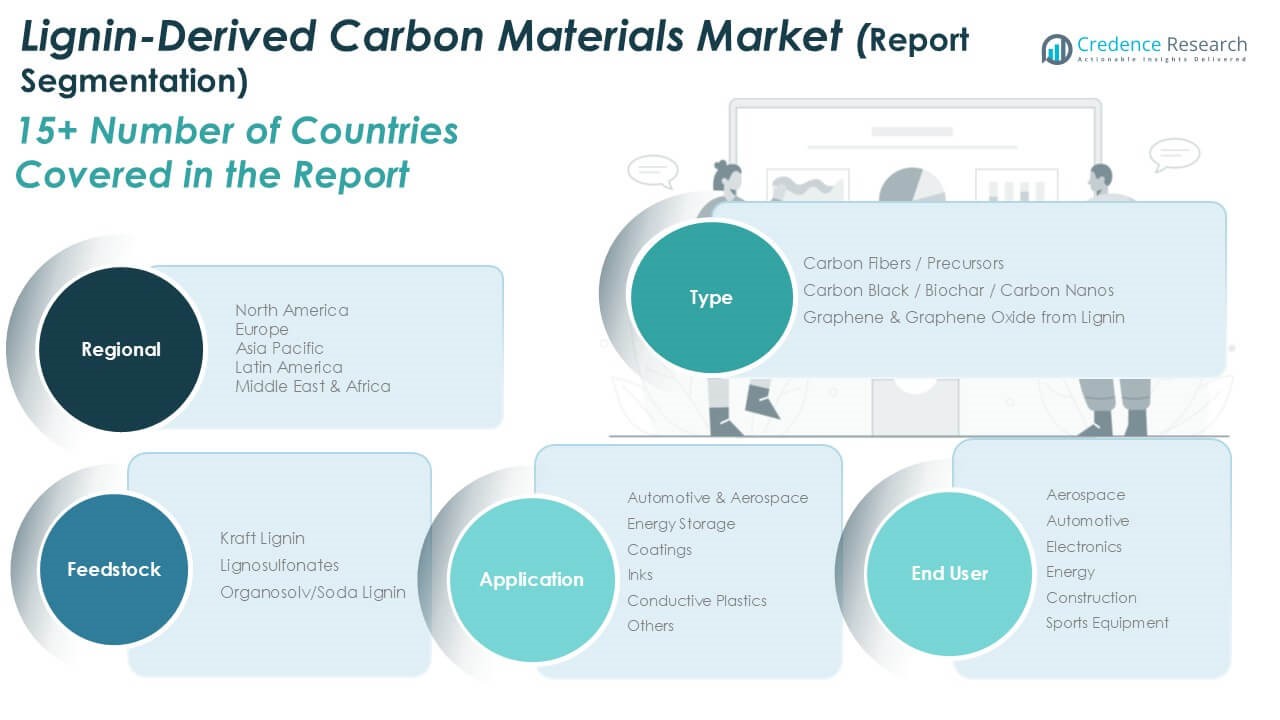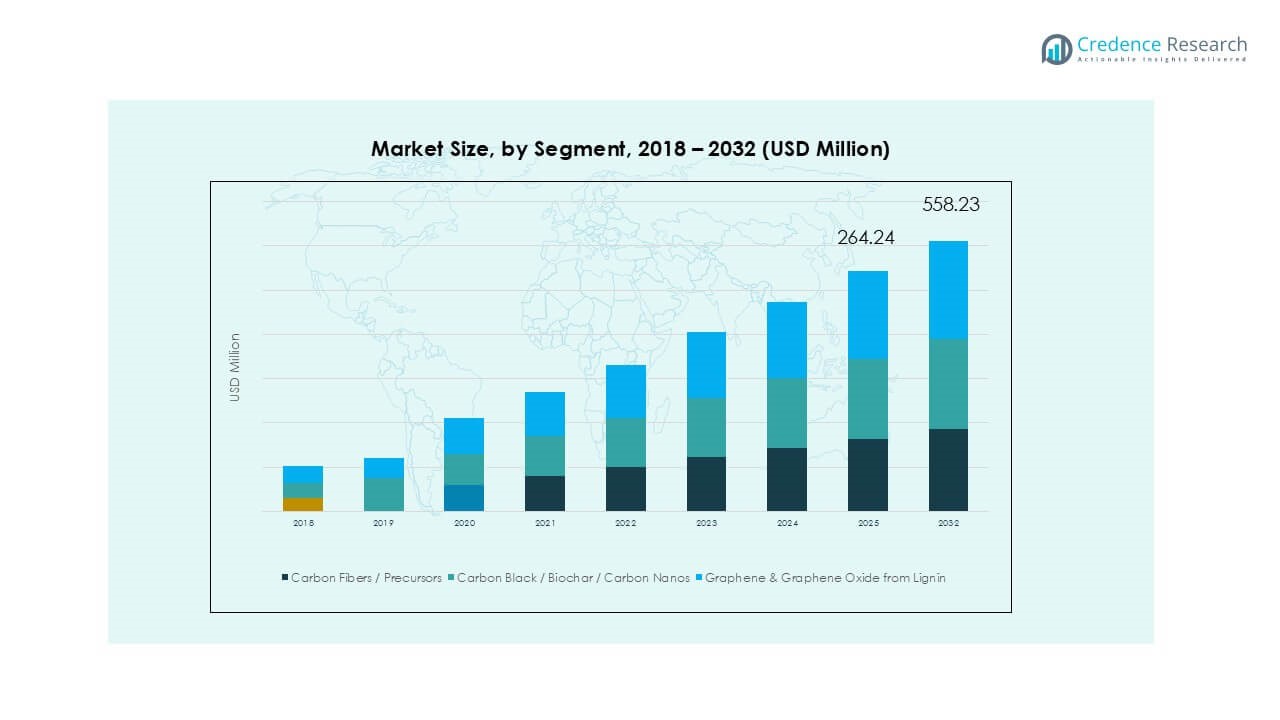CHAPTER NO. 1: GENESIS OF THE MARKET
1.1 Market Prelude – Introduction & Scope
1.2 The Big Picture – Objectives & Vision
1.3 Strategic Edge – Unique Value Proposition
1.4 Stakeholder Compass – Key Beneficiaries
CHAPTER NO. 2: EXECUTIVE LENS
2.1 Pulse of the Industry – Market Snapshot
2.2 Growth Arc – Revenue Projections (USD Million)
2.3. Premium Insights – Based on Primary Interviews
CHAPTER NO. 3: LIGNIN‑DERIVED CARBON MATERIALS MARKET FORCES & INDUSTRY PULSE
3.1 Foundations of Change – Market Overview
3.2 Catalysts of Expansion – Key Market Drivers
3.2.1 Momentum Boosters – Growth Triggers
3.2.2 Innovation Fuel – Disruptive Technologies
3.3 Headwinds & Crosswinds – Market Restraints
3.3.1 Regulatory Tides – Compliance Challenges
3.3.2 Economic Frictions – Inflationary Pressures
3.4 Untapped Horizons – Growth Potential & Opportunities
3.5 Strategic Navigation – Industry Frameworks
3.5.1 Market Equilibrium – Porter’s Five Forces
3.5.2 Ecosystem Dynamics – Value Chain Analysis
3.5.3 Macro Forces – PESTEL Breakdown
3.6 Price Trend Analysis
3.6.1 Regional Price Trend
3.6.2 Price Trend By Type
CHAPTER NO. 4: KEY INVESTMENT EPICENTER
4.1 Regional Goldmines – High-Growth Geographies
4.2 Product Frontiers – Lucrative Type Categories
4.3 Application Sweet Spots – Emerging Demand Segments
CHAPTER NO. 5: REVENUE TRAJECTORY & WEALTH MAPPING
5.1 Momentum Metrics – Forecast & Growth Curves
5.2 Regional Revenue Footprint – Market Share Insights
5.3 Segmental Wealth Flow – Type, Feedstock, Application, & End User Industry Revenue
CHAPTER NO. 6: TRADE & COMMERCE ANALYSIS
6.1. Import Analysis By Region
6.1.1. Global Lignin‑Derived Carbon Materials Market Import Revenue By Region
6.2. Export Analysis By Region
6.2.1. Global Lignin‑Derived Carbon Materials Market Export Revenue By Region
CHAPTER NO. 7: COMPETITION ANALYSIS
7.1. Company Market Share Analysis
7.1.1. Global Lignin‑Derived Carbon Materials Market: Company Market Share
7.2. Global Lignin‑Derived Carbon Materials Market Company Revenue Market Share
7.3. Strategic Developments
7.3.1. Acquisitions & Mergers
7.3.2. New Type Launch
7.3.3. Regional Expansion
7.4. Competitive Dashboard
7.5. Company Assessment Metrics, 2024
CHAPTER NO. 8: LIGNIN‑DERIVED CARBON MATERIALS MARKET – BY TYPE SEGMENT ANALYSIS
8.1. Lignin‑Derived Carbon Materials Market Overview By Type Segment
8.1.1. Lignin‑Derived Carbon Materials Market Revenue Share By Type
8.2. Carbon Fibers / Precursors
8.3. Carbon Black / Biochar / Carbon Nanos
8.4. Graphene & Graphene Oxide from Lignin
CHAPTER NO. 9: LIGNIN‑DERIVED CARBON MATERIALS MARKET – BY FEEDSTOCK SEGMENT ANALYSIS
9.1. Lignin‑Derived Carbon Materials Market Overview By Feedstock Segment
9.1.1. Lignin‑Derived Carbon Materials Market Revenue Share By Feedstock
9.2. Kraft Lignin
9.3. Lignosulfonates
9.4. Organosolv/Soda Lignin
CHAPTER NO. 10: LIGNIN‑DERIVED CARBON MATERIALS MARKET – BY APPLICATION SEGMENT ANALYSIS
10.1. Lignin‑Derived Carbon Materials Market Overview By Application Segment
10.1.1. Lignin‑Derived Carbon Materials Market Revenue Share By Application
10.2. Automotive & Aerospace
10.3. Energy Storage
10.4. Coatings
10.5. Inks
10.6. Conductive Plastics
10.7. Others
CHAPTER NO. 11: LIGNIN‑DERIVED CARBON MATERIALS MARKET – BY END USER INDUSTRY SEGMENT ANALYSIS
11.1. Lignin‑Derived Carbon Materials Market Overview By End User Industry Segment
11.1.1. Lignin‑Derived Carbon Materials Market Revenue Share By End User Industry
11.2. Aerospace
11.3. Automotive
11.4. Electronics
11.5. Energy
11.6. Construction
11.7. Sports Equipment
CHAPTER NO. 12: LIGNIN‑DERIVED CARBON MATERIALS MARKET – REGIONAL ANALYSIS
12.1. Lignin‑Derived Carbon Materials Market Overview By Region Segment
12.1.1. Global Lignin‑Derived Carbon Materials Market Revenue Share By Region
12.1.2. Regions
12.1.3. Global Lignin‑Derived Carbon Materials Market Revenue By Region
12.1.4. Type
12.1.5. Global Lignin‑Derived Carbon Materials Market Revenue By Type
12.1.6. Feedstock
12.1.7. Global Lignin‑Derived Carbon Materials Market Revenue By Feedstock
12.1.8. Application
12.1.9. Global Lignin‑Derived Carbon Materials Market Revenue By Application
12.1.10. End User Industry
12.1.11. Global Lignin‑Derived Carbon Materials Market Revenue By End User Industry
CHAPTER NO. 13: NORTH AMERICA LIGNIN‑DERIVED CARBON MATERIALS MARKET – COUNTRY ANALYSIS
13.1. North America Lignin‑Derived Carbon Materials Market Overview By Country Segment
13.1.1. North America Lignin‑Derived Carbon Materials Market Revenue Share By Region
13.2. North America
13.2.1. North America Lignin‑Derived Carbon Materials Market Revenue By Country
13.2.2. Type
13.2.3. North America Lignin‑Derived Carbon Materials Market Revenue By Type
13.2.4. Feedstock
13.2.5. North America Lignin‑Derived Carbon Materials Market Revenue By Feedstock
13.2.6. Application
13.2.7. North America Lignin‑Derived Carbon Materials Market Revenue By Application
13.2.8. End User Industry
13.2.9. North America Lignin‑Derived Carbon Materials Market Revenue By End User Industry
13.3. U.S.
13.4. Canada
13.5. Mexico
CHAPTER NO. 14: EUROPE LIGNIN‑DERIVED CARBON MATERIALS MARKET – COUNTRY ANALYSIS
14.1. Europe Lignin‑Derived Carbon Materials Market Overview By Country Segment
14.1.1. Europe Lignin‑Derived Carbon Materials Market Revenue Share By Region
14.2. Europe
14.2.1. Europe Lignin‑Derived Carbon Materials Market Revenue By Country
14.2.2. Type
14.2.3. Europe Lignin‑Derived Carbon Materials Market Revenue By Type
14.2.4. Feedstock
14.2.5. Europe Lignin‑Derived Carbon Materials Market Revenue By Feedstock
14.2.6. Application
14.2.7. Europe Lignin‑Derived Carbon Materials Market Revenue By Application
14.2.8. End User Industry
14.2.9. Europe Lignin‑Derived Carbon Materials Market Revenue By End User Industry
14.3. UK
14.4. France
14.5. Germany
14.6. Italy
14.7. Spain
14.8. Russia
14.9. Rest of Europe
CHAPTER NO. 15: ASIA PACIFIC LIGNIN‑DERIVED CARBON MATERIALS MARKET – COUNTRY ANALYSIS
15.1. Asia Pacific Lignin‑Derived Carbon Materials Market Overview By Country Segment
15.1.1. Asia Pacific Lignin‑Derived Carbon Materials Market Revenue Share By Region
15.2. Asia Pacific
15.2.1. Asia Pacific Lignin‑Derived Carbon Materials Market Revenue By Country
15.2.2. Type
15.2.3. Asia Pacific Lignin‑Derived Carbon Materials Market Revenue By Type
15.2.4. Feedstock
15.2.5. Asia Pacific Lignin‑Derived Carbon Materials Market Revenue By Feedstock
15.2.6. Application
15.2.7. Asia Pacific Lignin‑Derived Carbon Materials Market Revenue By Application
15.2.8. End User Industry
15.2.9. Asia Pacific Lignin‑Derived Carbon Materials Market Revenue By End User Industry
15.3. China
15.4. Japan
15.5. South Korea
15.6. India
15.7. Australia
15.8. Southeast Asia
15.9. Rest of Asia Pacific
CHAPTER NO. 16: LATIN AMERICA LIGNIN‑DERIVED CARBON MATERIALS MARKET – COUNTRY ANALYSIS
16.1. Latin America Lignin‑Derived Carbon Materials Market Overview By Country Segment
16.1.1. Latin America Lignin‑Derived Carbon Materials Market Revenue Share By Region
16.2. Latin America
16.2.1. Latin America Lignin‑Derived Carbon Materials Market Revenue By Country
16.2.2. Type
16.2.3. Latin America Lignin‑Derived Carbon Materials Market Revenue By Type
16.2.4. Feedstock
16.2.5. Latin America Lignin‑Derived Carbon Materials Market Revenue By Feedstock
16.2.6. Application
16.2.7. Latin America Lignin‑Derived Carbon Materials Market Revenue By Application
16.2.8. End User Industry
16.2.9. Latin America Lignin‑Derived Carbon Materials Market Revenue By End User Industry
16.3. Brazil
16.4. Argentina
16.5. Rest of Latin America
CHAPTER NO. 17: MIDDLE EAST LIGNIN‑DERIVED CARBON MATERIALS MARKET – COUNTRY ANALYSIS
17.1. Middle East Lignin‑Derived Carbon Materials Market Overview By Country Segment
17.1.1. Middle East Lignin‑Derived Carbon Materials Market Revenue Share By Region
17.2. Middle East
17.2.1. Middle East Lignin‑Derived Carbon Materials Market Revenue By Country
17.2.2. Type
17.2.3. Middle East Lignin‑Derived Carbon Materials Market Revenue By Type
17.2.4. Feedstock
17.2.5. Middle East Lignin‑Derived Carbon Materials Market Revenue By Feedstock
17.2.6. Application
17.2.7. Middle East Lignin‑Derived Carbon Materials Market Revenue By Application
17.2.8. End User Industry
17.2.9. Middle East Lignin‑Derived Carbon Materials Market Revenue By End User Industry
17.3. GCC Countries
17.4. Israel
17.5. Turkey
17.6. Rest of Middle East
CHAPTER NO. 18: AFRICA LIGNIN‑DERIVED CARBON MATERIALS MARKET – COUNTRY ANALYSIS
18.1. Africa Lignin‑Derived Carbon Materials Market Overview By Country Segment
18.1.1. Africa Lignin‑Derived Carbon Materials Market Revenue Share By Region
18.2. Africa
18.2.1. Africa Lignin‑Derived Carbon Materials Market Revenue By Country
18.2.2. Type
18.2.3. Africa Lignin‑Derived Carbon Materials Market Revenue By Type
18.2.4. Feedstock
18.2.5. Africa Lignin‑Derived Carbon Materials Market Revenue By Feedstock
18.2.6. Application
18.2.7. Africa Lignin‑Derived Carbon Materials Market Revenue By Application
18.2.8. End User Industry
18.2.9. Africa Lignin‑Derived Carbon Materials Market Revenue By End User Industry
18.3. South Africa
18.4. Egypt
18.5. Rest of Africa
CHAPTER NO. 19: COMPANY PROFILES
19.1. Stora Enso Oyj
19.1.1. Company Overview
19.1.2. Service Portfolio
19.1.3. Financial Overview
19.1.4. Recent Developments
19.1.5. Growth Strategy
19.1.6. SWOT Analysis
19.2. UPM‑Kymmene Corporation
19.3. Domtar Corporation
19.4. Borregaard ASA / Borregaard LignoTech
19.5. Nippon Paper Industries Co., Ltd.
19.6. Suzano S.A.
19.7. West Fraser Timber Co. Ltd.
19.8. Rayonier Advanced Materials Inc.
19.9. Lignol Innovations Ltd.
19.10. GreenValue Enterprises LLC
10.11. Renewable Carbon Fiber LLC
10.12. Technip Energies (industrial-scale processing)
10.13. Toray Industries, Inc.
10.14. SGL Carbon SE
10.1.5. American Process Inc










